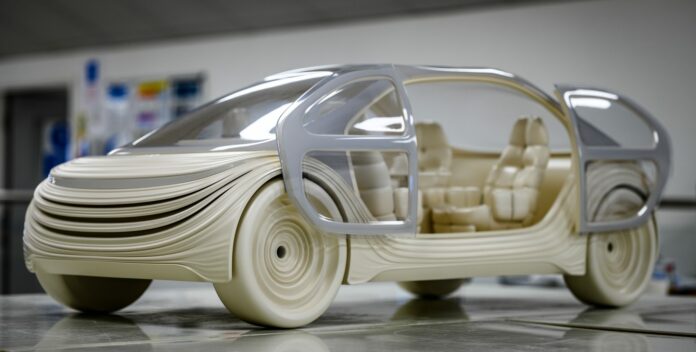Ogle, a provider of 3D printing, prototyping and model making services, took part in the creation of a concept all-electric vehicle for British design and architecture studio Heatherwick Studio, which had been commissioned by IM Motors, electric vehicle joint venture between Chinese automobile manufacturer SAIC Motor and Chinese technology companies Zhangjiang Hi-Tech and Alibaba Group.
The ultimate goal of the project was to manufacture the Airo, a new vehicle with driver and autonomous controls. If the manufacturing of the end-product is successful, the car should be able not to produce any of its own emissions because the use of a HEPA filtering system will enable to remove pollutants from around the vehicle as it travels.
As far as design and manufacturing are concerned, the project involved modifying the supplied CAD to suit Ogle’s processes, 3D printing SLAs and hand-finishing.
The design and manufacturing process
The 1:4 scale (1200mm long) model needed an incredibly high level of detail, making the stereolithography (SLA) process the most suitable. Designers and engineers prefer SLA because of the accuracy, surface finish and wide variety of materials available.
Around 180 hours were spent creating the Airo model, involving a number of team members from the rapid prototyping department, who carried out the 3D printing, the hand-finishing of the SLA prints and the assembly. The paint department also had several people working on it delivering the final finish.
The CAD model supplied by the client was split by Ogle into separate parts, according to the different finishes that would be needed. Because of its size, the main body had to be split in half to fit on the build platform. This was one of the challenges the team faced. To make it easier for them, the team created a lap joint and pin holes to enable the two sections to be assembled, as well as extra supports being added to make sure the wheels could support the weight of the completed model. The wheels were also partially filled with resin to give them extra strength, without the added cost of using the SLA resin itself.
Furthermore, in the original plan, the bodywork was going to cover the windows, which would have provided an ideal place to bond the windows to the body. But the design was changed at the last minute with the windows covering the entire top of the car. That presented the problem of how to bond the windows to the bodywork; any glue or tape on the inside of the clear windows would show through and reduce the quality of the model.
Ogle’s specialists overcame this by masking and painting obscuration bands on the inside of the windows where the body frames sat against the windows. This provided a good surface to bond against without being visible.
The manufacturing required the use of two in-house Neo800 3D printers. As a reminder, the 3D printers are developed and commercialized by RPS, a British OEM that is now a Stratasys company. They are an open platform with a print volume of 800 x 800 x 600 mm, that can run 24/7 while processing a wide range of (third-party & proprietary) SLA resins.
In this specific case, the main body parts were printed in white on one machine while the second produced the clear parts for the windows. Thin lenses have also been 3D printed to improve the car concept.
All the parts were hand-finished by Ogle’s specialists and assembled to make sure everything would fit perfectly, including seamlessly bonding together the two halves of the car. The next step was to send the parts to the paint shop. Once all the sections had been painted and polished to a high standard, they were reassembled and bonded together bringing the model to life.
According to Mikael Nordstrom, from the rapid prototyping team, “the final model was impressive. It was a lot of work to get to the end, but when [they] saw the final pieces go on and everything assembled it made all the hard work and effort worth it.”
Remember, you can post your job opportunities in the AM Industry on 3D ADEPT Media or look for a job via our job board. Make sure to follow us on our social networks and subscribe to our weekly newsletter : Facebook, Twitter, LinkedIn & Instagram ! If you want to be featured in the next issue of our digital magazine or if you hear a story that needs to be heard, make sure you send it to contact@3dadept.com


